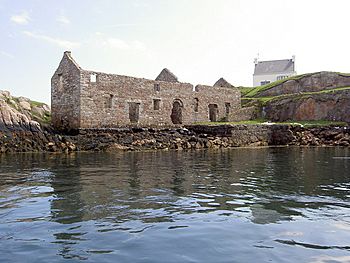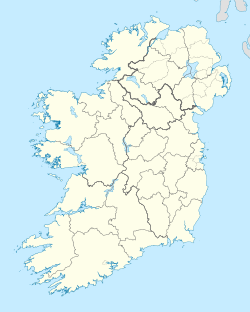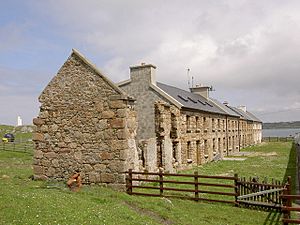Rutland Island, County Donegal facts for kids
|
Native name:
Inis Mhic an Doirn
|
|
|---|---|

Remains of Conyngham's fishing complex on Rutland Island.
|
|
| Geography | |
| Location | Atlantic Ocean |
| Coordinates | 54°58′45″N 8°27′32″W / 54.97917°N 8.45889°W |
| Administration | |
| Province | Ulster |
| County | Donegal |
| Demographics | |
| Population | 12 (2022) |
Rutland Island (Inis Mhic an Doirn in Irish), sometimes called Inishmacadurn, is an island in County Donegal, Ireland. It is also part of a larger area used for counting people, which includes nearby islands and a piece of the mainland. The island itself does not have people living there all the time. However, the wider area, including the town of Burtonport, had 1,428 residents in 2006. The island is located between Burtonport and the island of Arranmore, which does have people living on it. There is no official ferry service to Rutland Island.
Contents
Exploring Rutland Island's Past
Rutland Island used to have people living on it. A planned village was started by William Burton Conyngham in 1784. This village included a street with homes and shops. It also had the area's post office, a school, and a place to land and process fish.
However, the amount of fish caught dropped a lot soon after the village was built. Many services closed or moved away. Despite this, people continued to live on the island until the 1960s.
Electricity came to the island in 1957. This was because Rutland Island was an important stop for the power lines going to Arranmore Island. But, the homes that are left on Rutland Island have never had running water pipes. Today, all the houses on the island are used as holiday homes. Rutland Island has become a popular place for holidays. Many new holiday homes were built there in the early 2000s.
How Many People Lived Here?
The table below shows how the number of people on Rutland Island has changed over time. This information comes from a book called Discover the Islands of Ireland and the official Census of Ireland. A census is like a big count of all the people living in a country. Before 1841, the census information in Ireland might not be complete or fully correct.
| Historical population | |||||||||||||||||||||||||||||||||||||||||||||||||||||||||||||||||||||||||||||||||||||||||
|---|---|---|---|---|---|---|---|---|---|---|---|---|---|---|---|---|---|---|---|---|---|---|---|---|---|---|---|---|---|---|---|---|---|---|---|---|---|---|---|---|---|---|---|---|---|---|---|---|---|---|---|---|---|---|---|---|---|---|---|---|---|---|---|---|---|---|---|---|---|---|---|---|---|---|---|---|---|---|---|---|---|---|---|---|---|---|---|---|---|
|
|
|
|||||||||||||||||||||||||||||||||||||||||||||||||||||||||||||||||||||||||||||||||||||||
| Source: | |||||||||||||||||||||||||||||||||||||||||||||||||||||||||||||||||||||||||||||||||||||||||
Animals of Rutland Island
Rutland Island is home to some interesting animals. Badgers have been seen on this island. There are also some foxes living here.
Plant Life on Rutland Island
The waters around Rutland South Channel have many types of algae. Algae are simple plant-like organisms that live in water. Some of the algae found here include: Gracilaria gracilis, Rhodymenia holmesii, Polysiphonia fucoides, Polysiphonia nigra, Sphondylothamnion multifidum, and Heterosiphonia plumosa.



